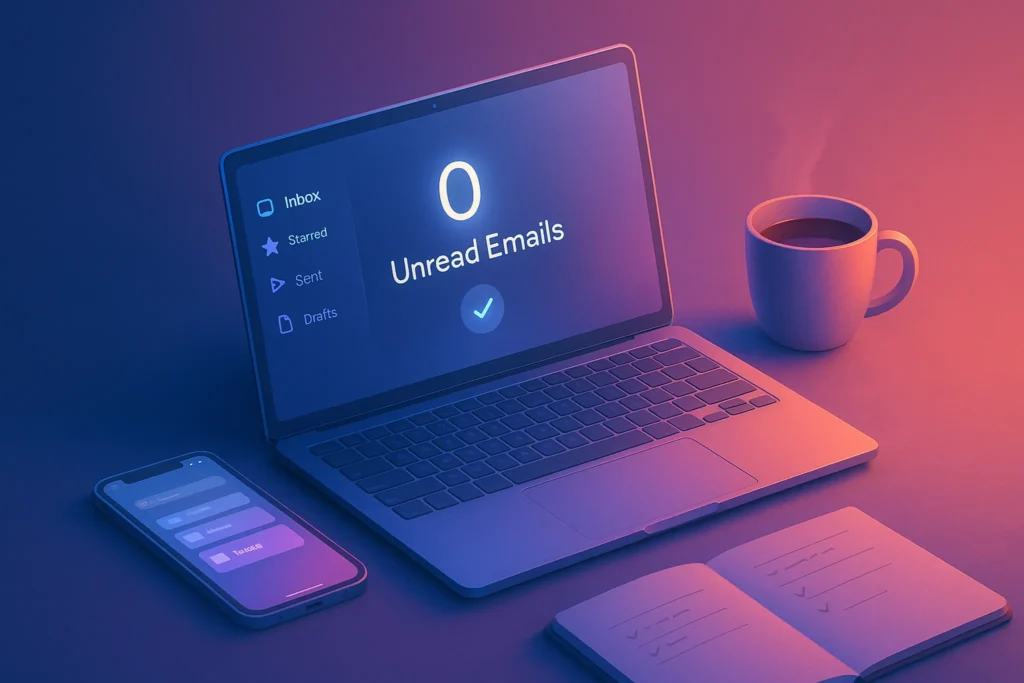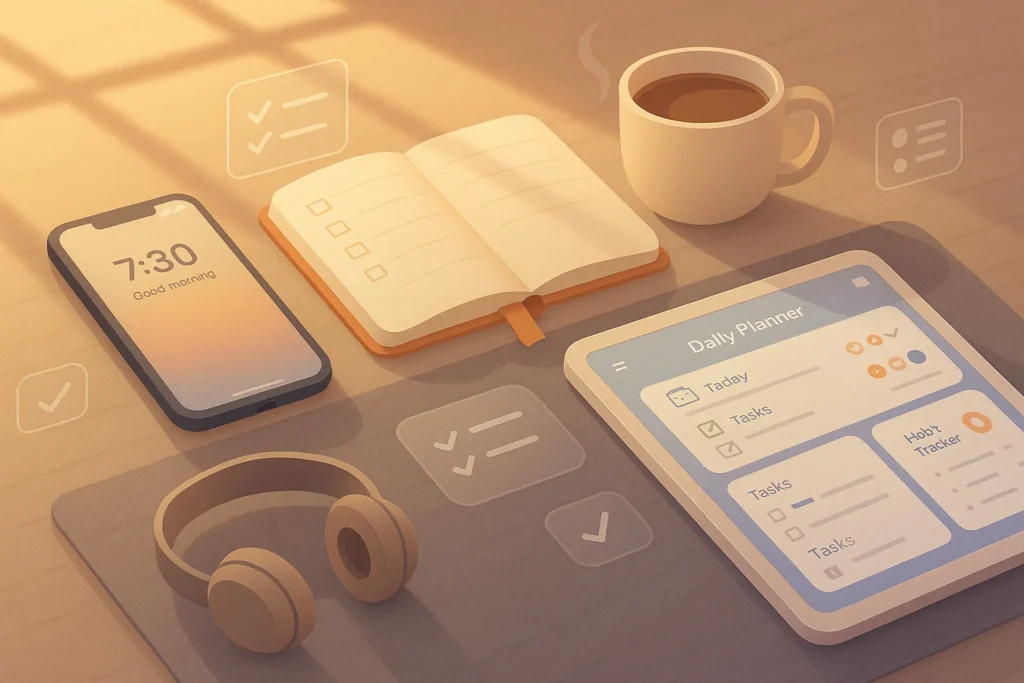-This post may contain affiliate links. If you click on one and make a purchase, I may earn a small commission at no extra cost to you.-
🧭 Introduction: Take Control Without Email Anxiety
Email can be your biggest ally—or your worst distraction. What if you could reach Inbox Zero without feeling chained to your inbox, checking it obsessively?
This guide gives you a clear, sustainable path to email mastery using:
-
The core email mindset shift
-
Simplified triage & processing sessions
-
Smart filtering and archiving
-
Scheduled email slots and response routines
-
Essential tools to speed things up
You’ll learn to keep your inbox clean, your attention protected, and your emails under control—without obsession or guilt.
1️⃣ Core Mindset Shift: Email is Not Your To‑Do List
The key difference between stress and control is mindset. Most people treat email as a task hub, leading to constant reactivity.
Inbox Zero works when you redefine your inbox as a “processing center” only. It’s not where tasks live—it’s where requests arrive.
When a new email comes in:
-
Delete: Junk, promotions, irrelevant
-
Delegate: Forward with action added to your system
-
Defer: Convert to task or calendar
-
Do: If it takes <2 minutes, reply immediately
-
Archive: Once processed, clear it out
This five‑step approach, known as DTFDA, ensures every email hits the correct path—keeping your inbox clean and your mind free.
2️⃣ Master the Triage Session: Process, Don’t Peek
Most inbox clutter happens from endless checking. The antidote? Scheduled, focused triage sessions:
-
Once at 9 AM and once at 3 PM, set aside 15–20 minutes
-
During triage: apply DTFDA to every unread message
-
Don’t read beyond the first line—process fast
-
Skip non-urgent threads (label or archive immediately)
This disciplined habit builds up mental bandwidth and prevents email from hijacking your whole day.
Tip: Use “Mark as Unread” or Snooze to defer messages you can’t address in that session.
3️⃣ Automate Smart Filters & Archiving
Email rules save you time every day—but most people never set them up.
Start with these essential filters:
-
Newsletters → “Read Weekly” folder
-
Receipts/Billing → “Finance” label + auto-archive
-
Alerts & Notifications → “Info” folder
-
High-priority senders (boss, key clients) → VIP label
Auto-archive everything else. Trust the system—you can always search, but let it stay hidden until needed.
This framework ensures only meaningful emails land in your main inbox. It’s proactive, not reactive.
4️⃣ Schedule & Respect Your Email Time
Every distraction resets your focus—it takes ~23 mins to regain it. Email is the No. 1 saboteur.
Combat context‑switching by time-blocking email:
-
Email Block 1: 9 AM – triage + task replies
-
Email Block 2: 1 PM (after lunch) – client follow‑ups
-
Email Block 3: 4 PM – clear inbox and prepare tomorrow
Honor these as if they were client meetings—notifications silenced outside.
When outside email time? Clear your mind: “I’m not checking email until my next block.”
5️⃣ Use Tools That Keep You Focussed
There’s no rule requiring fancy tools—your system can work on Gmail or Outlook. But the right apps can amplify your results:
-
Sanebox: Automatically snoozes low‑priority emails away for you
-
Unroll.Me: Turns noisy subscriptions into a daily digest
-
Superhuman: Offers lightning-fast shortcuts and scheduled send
-
Clean Email: Helps bulk-clear your inbox and manage filters
Include CTAs where you naturally recommend each tool with affiliate links, highlighting free trials and benefits (e.g., “Try Sanebox with a free 14-day trial to filter family vacation threads automatically”).
🔄 Inbox Zero as a Habit: Daily & Weekly Rituals
Daily:
-
Two triage sessions
-
Archive everything processed
-
Clear inbox by 5 PM daily
Weekly Review:
-
Pause for 10 minutes every Friday
-
Check “Finance,” “Needs Follow-up,” “Info” folders
-
Clean out low-value mail (archived or unread older than 30 days)
Over time, your inbox becomes fast, actionable, and psychologically refreshing. No dread or data dump—just clarity.
🔄 Bonus Section: 5 Types of Email That Destroy Focus (And How to Handle Them)
Even the best systems fail when emotional triggers hijack logic. Let’s decode the worst offenders in your inbox—and how to deal with them fast and fearlessly.
1. 🔥 “Can You Do This Today?” Requests
Often from managers or clients, these create pressure and guilt. First, pause. If it wasn’t in today’s block, it doesn’t auto-get your focus.
Fix: Use templated responses like:
“Thanks! I’ll review and get back to you by [realistic time].”
Move it to your triage list, and reclaim your calm.
2. 🕳️ “FYI Only” CC Threads
They clog up visibility and create fear of missing out.
Fix: Auto-label these as “Low Attention” and batch-read weekly. Unsubscribe from repeated CC chains or kindly ask to be removed from threads not requiring action.
3. 🧨 Emotionally Charged Replies
A passive-aggressive comment or critique email can derail your mood.
Fix: Don’t respond immediately. Archive into “Handle Later” and set a 24h delay. Respond with clarity—not emotion.
4. 🧲 Newsletters That Look Productive
That “Top 10 Tools You Missed” or “Weekly AI Roundup” feels valuable—but usually isn’t urgent.
Fix: Filter into a “Curated Read” label. Batch-read on Fridays or during lunch blocks.
5. 🪤 Tricky Auto-Confirmations (passwords, billing, etc.)
These are necessary but clutter central.
Fix: Auto-label and archive to “Transactions.” Set reminders elsewhere—not in your inbox.
This section alone can remove 30–40% of daily inbox anxiety by proactively neutralizing noise and emotional friction.
📈 Behavioral Psychology Behind Email Anxiety (and How to Beat It)
Why do we obsessively check email—especially when we know it’s hurting focus?
📌 It’s dopamine.
Each new email offers the chance of novelty, reward, or validation. It’s a slot machine we pull 26 times a day.
📌 It’s fear.
Fear of missing out. Fear of forgetting. Fear of being seen as slow or unresponsive.
📌 It’s lack of structure.
When email is always available, our brain takes the easiest, least friction path. And clicking Inbox is easier than solving problems.
🧠 The 3-Part Psychological Fix
-
Create Distance
Move email icons off your home screen. Don’t auto-load Gmail tabs. Reduce exposure. -
Design Response Windows
Block times to check email—and train others that you only respond within those windows. Add this to your signature or calendar status. -
Reward Real Work
After clearing a deep work block, reward yourself with 10–15 minutes of triage. Flip the pattern: don’t let email interrupt flow—let it follow it.
💡 How to Build Your “Quick Response” System
Not every email needs a handcrafted reply. Some can be standardized and rapid-fire—especially if you deal with clients, support, or internal teams.
Create a Quick Response Library with:
-
✅ “Acknowledged—Will Reply Soon”
-
✅ “Here’s the file/request you need”
-
✅ “This isn’t my area—forwarding to [Name]”
-
✅ “Thanks for following up. Let me circle back by [Date]”
Store these in TextExpander, Notion, or Gmail Canned Responses.
Over time, your speed rises, your mental fatigue drops, and inbox burnout fades away.
🚀 Level Up: Create Your Email Review Dashboard in Notion
Instead of letting your inbox own your day—build a review dashboard.
Suggested Blocks:
-
🔁 Today’s Follow-Ups – manually added from triage
-
📨 Snoozed Emails To Review – quick table
-
📎 Waiting on Reply – for emails where you await action
-
📬 Newsletter Digest – linked to Friday block
-
🧹 Weekly Cleanout – summary table (archive, delete, reply)
You now run your inbox—not the other way around.
📘 Mini Case Study: From 4,200 Emails to Inbox Calm in 6 Days
Meet Sam, a freelance designer juggling multiple clients. His Gmail inbox had grown to over 4,200 unread emails. He checked it constantly, responded late, and dreaded every Monday.
Here’s how Sam regained control using this Inbox Zero method:
-
Day 1: Archived all emails older than 90 days into an “Old Inbox” folder. This removed 3,000+ irrelevant items in 10 minutes.
-
Day 2–3: Created VIP filters for clients and set up auto-labels for newsletters, receipts, and notifications.
-
Day 4: Adopted two 20-minute triage windows (10AM & 4PM), closed inbox outside those times.
-
Day 5–6: Built a Notion dashboard to track follow-ups and delegated messages.
Now? He gets 20–30 emails/day, 90% of which are processed within 30 minutes total. Sam says the biggest change wasn’t his inbox—it was his headspace.
“I finally stopped reacting and started working again.”
⚙️ Bonus: Set Up Inbox Zero in Gmail (Template Flow)
If you’re using Gmail, this 5-step flow will fast-track your setup:
-
Create Labels: VIP, Newsletters, Finance, Admin, Waiting, Action Needed
-
Filters:
-
From: [@newsletters.com] → Skip Inbox, Apply “Newsletters”
-
From: client@domain → Apply “VIP,” Mark as Important
-
Subject: “receipt” OR “payment” → Apply “Finance”
-
-
Snooze: For messages that require future attention—use “Later Today,” “Tomorrow,” or “This Weekend”
-
Templates: Use Gmail Canned Responses to speed up replies
-
Auto-Advance: Turn this on to jump to the next email after action
With this setup, you’ll cut email time in half and remove 90% of inbox clutter within days.
🔄 7-Day Email Detox Challenge
Want to go deeper? Try this micro-challenge:
| Day | Focus |
|---|---|
| 1 | Archive everything older than 60 days |
| 2 | Create 3 labels: Action, Waiting, Newsletters |
| 3 | Set up Gmail filters (or Outlook rules) |
| 4 | Schedule 2 triage windows into your calendar |
| 5 | Build a “Quick Reply” template library |
| 6 | Clean your inbox down to <25 messages |
| 7 | Review weekly—set future rules, delete dead weight |
Most people who try this report a 60–70% drop in email anxiety by Day 5.
🧠 Nerd Verdict
The secret to sustainable Inbox Zero isn’t inbox elimination—it’s mastering how to process email. When you combine a disciplined mindset, focused triage, strong filters, scheduled email windows, and the right tools, you’ll stop being a slave to the inbox and start working intentionally.
❓ FAQ
Q: What if my job demands immediate replies?
A: Set expectations—use auto‑reply outside triage times or a “client channel” for urgent matters.
Q: Will I miss important emails with filters?
A: No. Labels stay searchable and you can set VIP or forwarding alerts for key senders.
Q: Can this work for shared or group inboxes?
A: Absolutely—just define team ownership, shared labels, and coordinate triages.
Q: Email zero or stress zero?
A: Both. An empty inbox is the result of a stress-free system, not the goal itself.
💬 Would You Bite?
Where do you struggle most: filtering, frequency, or follow-up?
Drop your challenge below. I’ll reply with tips, examples, or screenshots to help you master email—for real. 👇



